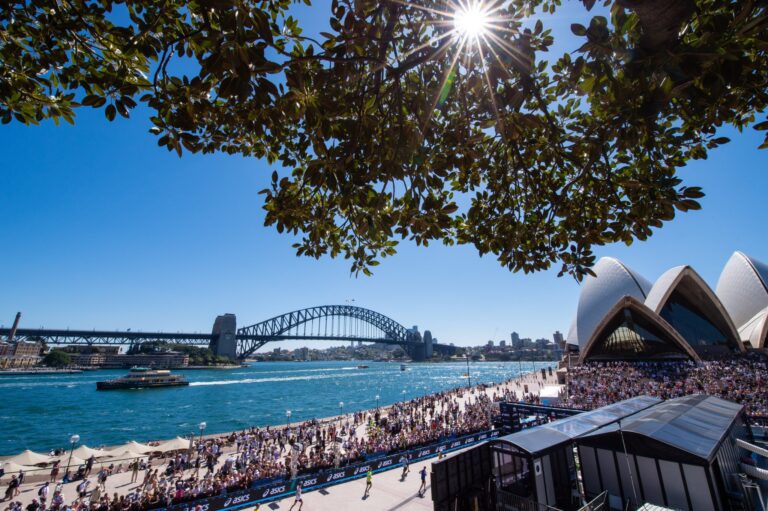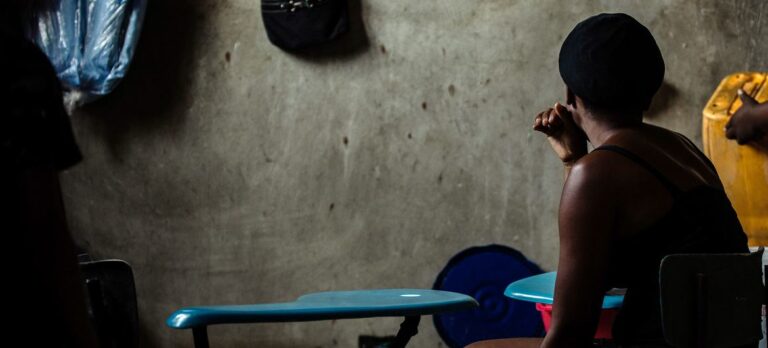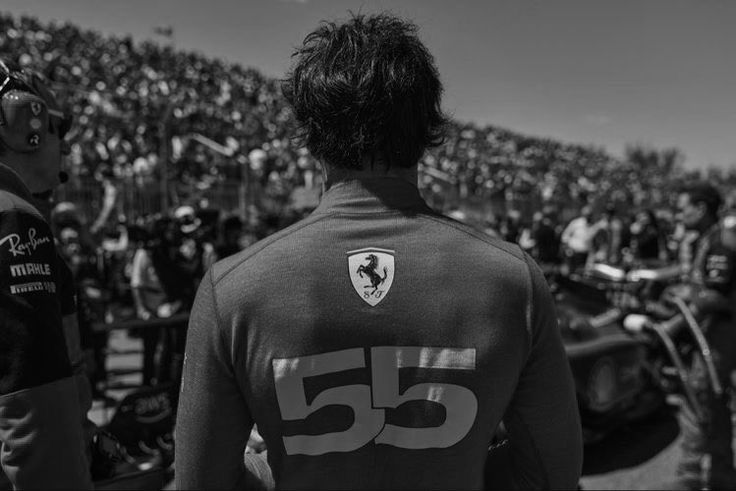Era by Era: Bhansali’s Costume Art
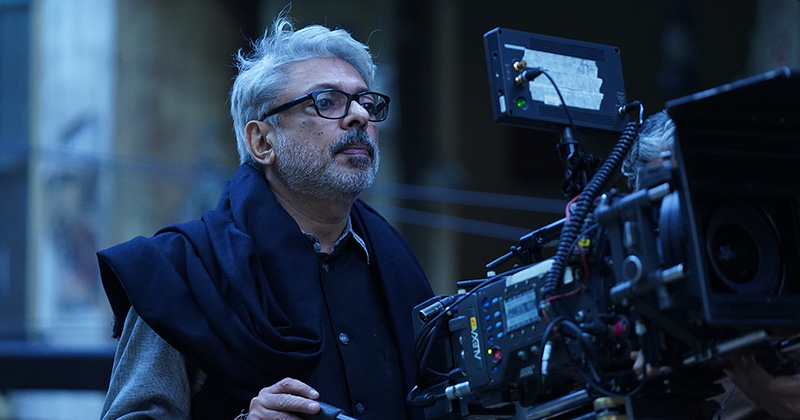
When you see royalty, grandeur, and perfectly designed sets, you know you’re watching a Bhansali production. Sanjay Leela Bhansali has long been a fan favourite for his elaborately crafted sets and lavish costumes. He never fails to awe his audience by taking them to another era all together. With a unique ability to make already gripping stories even more immersive through visual detail. Bhansali’s costumes are used as storytelling tools.
But how many of these elements are actually accurate to the time periods his projects are set in? Does he simply rely on grandeur? Does he truly give weight to historical timelines and settings? And is that what sets him apart from others in the industry?
Let’s explore the historical accuracy of the costumes used by Sanjay Leela Bhansali in some of his most prominent films.
Hum Dil De Chuke Sanam (1999)
The movie is set in Gujarat in the late 1990s. The main character, Nandini (played by Aishwarya Rai), is the daughter of an Indian classical music guru. True to that background, Nandini is dressed in modest yet elaborate outfits that reflect her cultural roots. She almost appears to be a living embodiment of an Indian classical composition.
Wearing Gujarati-style lehenga cholis and vibrant, heavily embroidered ensembles in her youth, and transitioning into more modest sarees after marriage. Bhansali gets everything right in terms of costume design. The clothing not only fits the setting but also reflects Nandini’s emotional and personal journey.
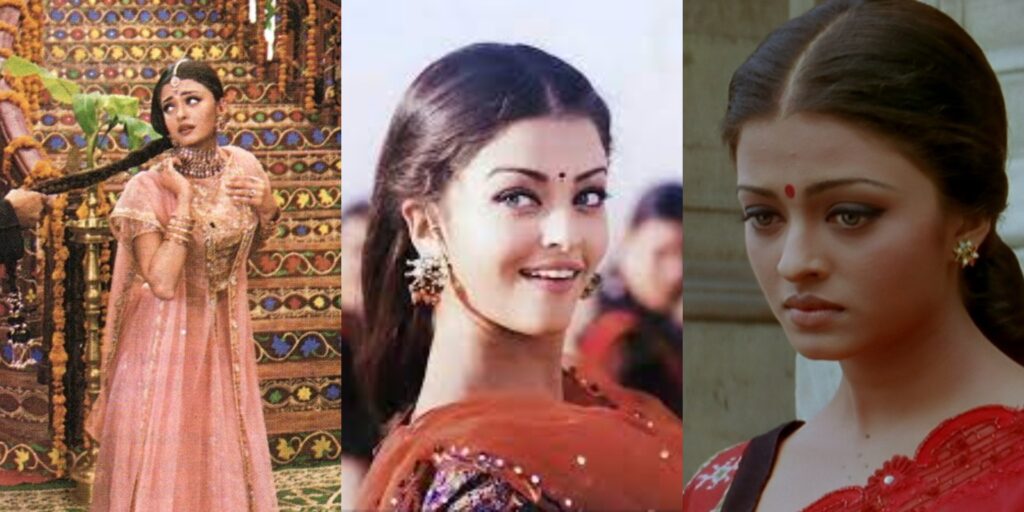
Devdas (2002)
Based on the classic novel by Sarat Chandra Chattopadhyay (1917), Devdas is set in early 1900s colonial Bengal. It is a timeless tale of love, longing, and heartbreak. Brought to life through Sanjay Leela Bhansali’s signature visual style, especially his delicately designed costumes that radiate the emotional depth and cultural richness of the era.
The story follows Devdas, a young man returning from London, torn between love and societal expectations. His wardrobe perfectly reflects this duality. Part British-educated ‘babu’, part traditional Bengali aristocrat. Crisp sherwanis, angarakhas, and embroidered shawls mark his presence.
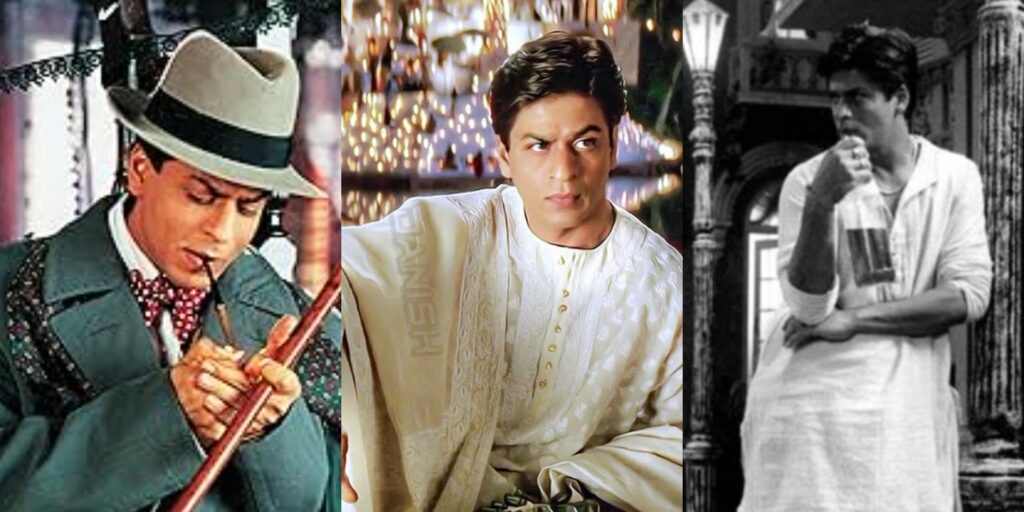
The women, are draped in rich silks, heavy jewellery, and sarees that mirror the elegance of upper-class Bengali women in the colonial era. Their costumes capture both the grace and constraint of their lives. Adorned with era-accurate details, especially the bold, round bindis and bright red alta, distinctive of Bengali tradition.
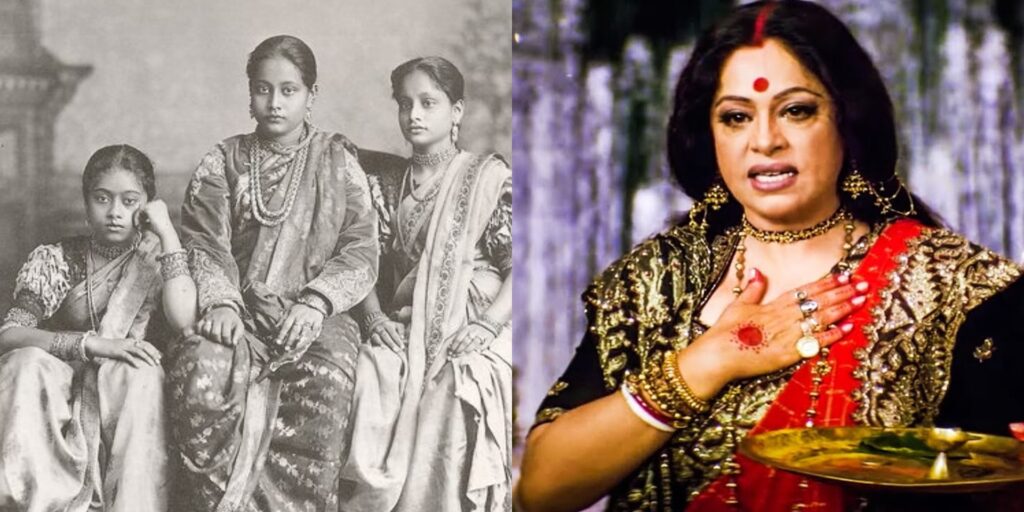
Guzaarish (2010)
Set in 2010 Goa, Guzaarish tells the story of Ethan Mascarenhas (Hritik Roshan), a former magician now paralyzed and seeking euthanasia. The film’s melancholic tone is matched by its gothic, Portuguese-influenced aesthetic.
Ethan’s rich velvets, layered coats, and vintage cravats reflect his lost grandeur. Aishwarya Rai’s Sofia wears flowy gowns, dark hues, pinned-up hair, and large roses, blending gothic drama with quiet grief.
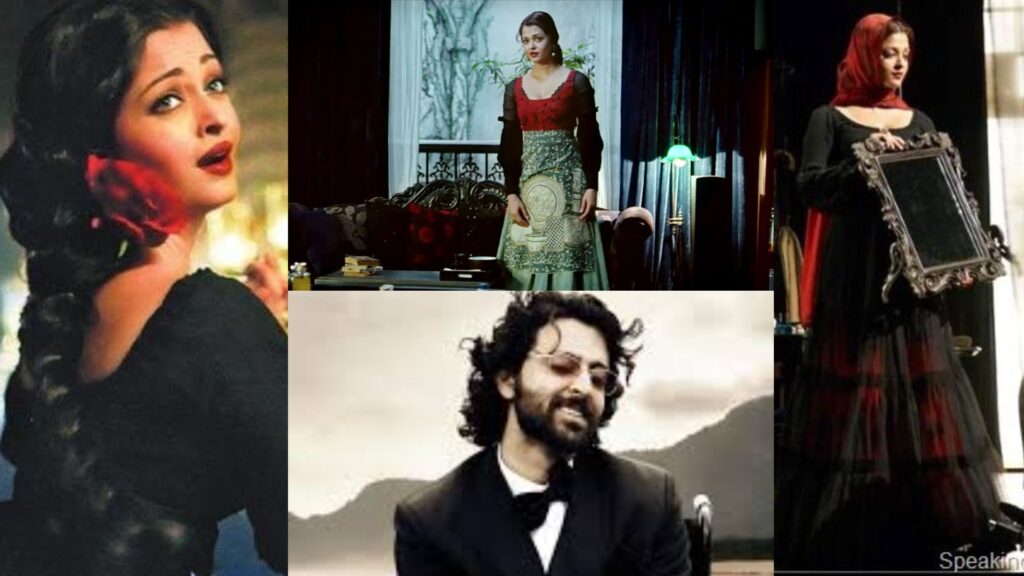
Bhansali doesn’t go for realism! He goes for psychological turmoil. His costumes reflect the melancholic opulence of the characters’ internal worlds. Where every rose in the hair and every fold of fabric tells a story.
Goliyon Ki Raasleela Ram-Leela (2013)
Set in Gujarat, Ram-Leela reimagines Romeo and Juliet amidst local feuds, love, and tradition. Bhansali blends drama with authentic cultural detailing, especially in costume design.
The film showcases elements of traditional Gujarati attire. Chaniya cholis (flared skirts with embroidered blouses), bandhani dupattas (tie-dyed shawls), and heavy kutchi mirror work. Typical of the Kutch and Saurashtra regions. Deepika’s looks feature backless cholis with low necklines, giving a modern twist to heritage wear, while still rooted in traditional cuts and fabrics.
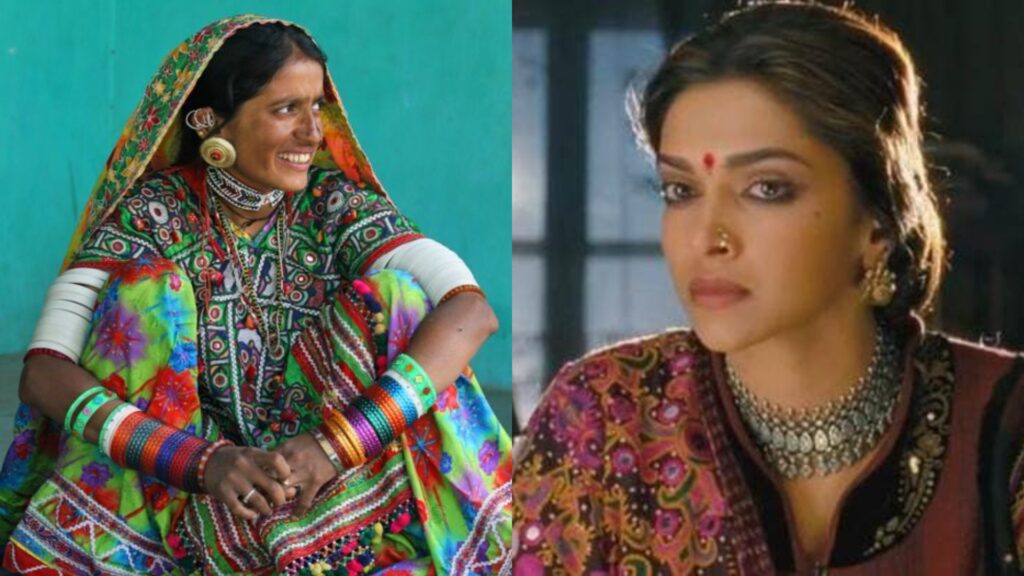
Ranveer sports kediyu-style kurtas, embroidered jackets, and bandhani turbans, reflecting local male attire with bold, masculine energy.
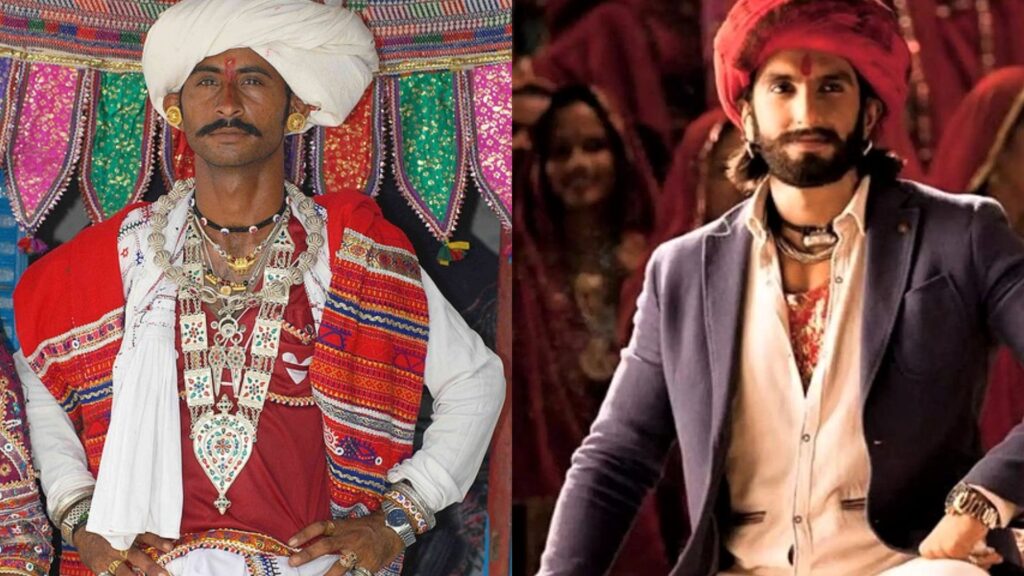
The film showcases traditional Gujarati jewellery like borlas, chaandbalis, kadas, and jadau rani haars, rooted in Kutch and Rajput craftsmanship. Deepika’s look is completed with kamarbands, payals, and oxidized silver pieces, while Ranveer sports silver earrings and layered necklaces.
Bajirao Mastani (2015)
Set in 18th-century Maratha India, Bajirao Mastani is not just a love story. It’s a visual epic of power, passion, and sacrifice.
Bajirao (Ranveer Singh) is dressed in traditional silk angrakhas, embroidered jamas, and dhoti pants, with rich but restrained detailing that reflects his warrior discipline and royal stature. His turbans and minimal jewellery symbolize duty and control.
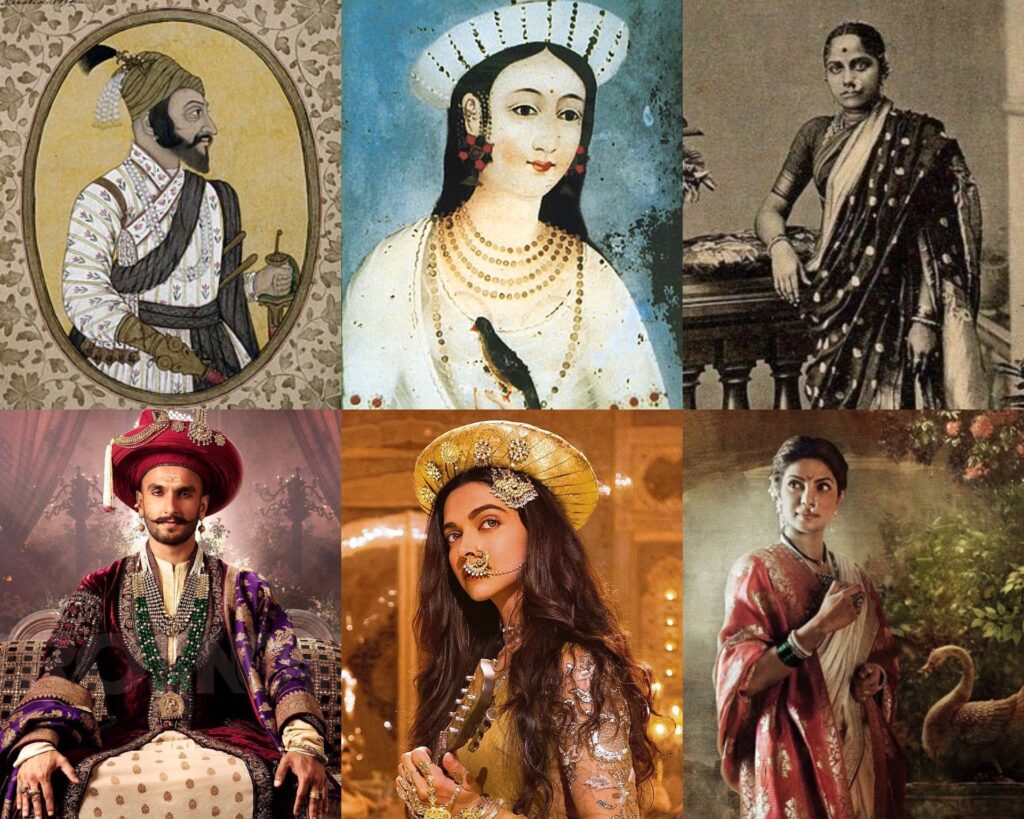
Mastani (Deepika Padukone), a warrior princess of mixed Rajput-Muslim heritage, Wears anarkalis, floor-length angrakhas, and lightweight dupattas. Often blending Mughal and Rajput silhouettes.
Kashibai (Priyanka Chopra), Bajirao’s first wife, Often dressed in traditional nauvari sarees, with paithani silk, gold borders, and bold colours that mirror her dignity and suppressed sorrow.
The jewellery is deeply rooted in Maratha tradition. From mundavlya (pearl strings tied across the forehead during weddings), naths, chandbalis, and temple-style gold necklaces, to kadas and waistbands. Mastani’s jewellery, lighter and Mughal-influenced, sets her apart visually, underlining her outsider status.
Padmaavat (2018)
Set in 13th-century Rajasthan. Padmaavat is a cinematic ode to Rajput valour, sacrifice, and honour.
Rani Padmavati (Deepika Padukone) is adorned in handwoven lehengas, odhnis, and rajputi poshaks crafted with zari, gota patti, and rich banarasi silks. The 16 kg costume in the climax reflects not just grandeur, but the emotional weight of her final decision.
Her jewellery is a stunning revival of Rajasthani royal heritage. Borlas, maang tikkas, kundan rani haars, naths, sheeshphools, and chooda bangles dominate her regal look. These weren’t just ornaments but cultural symbols of pride, purity, and marital status.
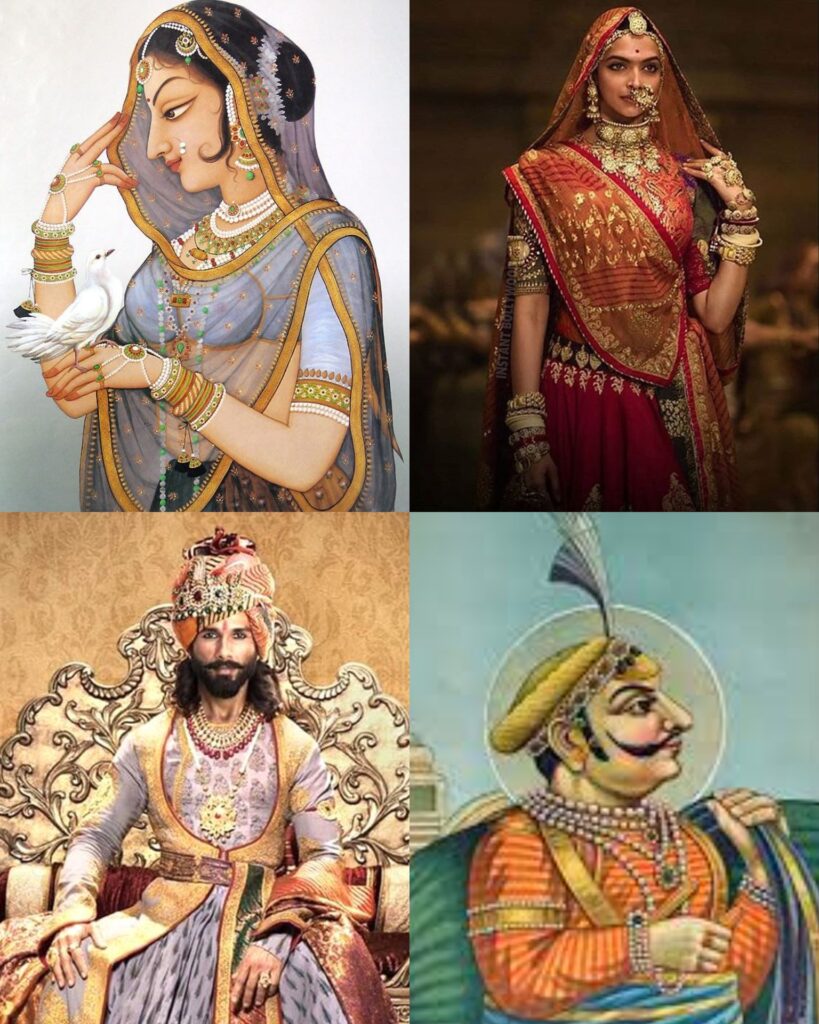
Maharawal Ratan Singh(Shahid Kapoor) wears angrakhas, dhoti pants, safa turbans, and swords strapped in embroidered belts, reflecting Rajput masculinity and stoicism.
In contrast, Alauddin Khilji (Ranveer Singh) is styled in darker, deconstructed armour, layered fabrics, and fur. Wild and raw, just like his character.
Gangubai Kathiawadi (2022)
Set in the 1950s-60s Kamathipura of Bombay. Gangubai Kathiawadi traces the journey of a naive girl turned fearless madam and activist.
Bhansali uses costumes as a visual timeline. Showcasing Gangubai’s rise, resilience, and rebellion through fabric, cut, and colour.
Early in the film, Gangubai (Alia Bhatt) is seen in soft, pastel-toned sarees with floral prints—modest and innocent, reflecting her young, vulnerable self.
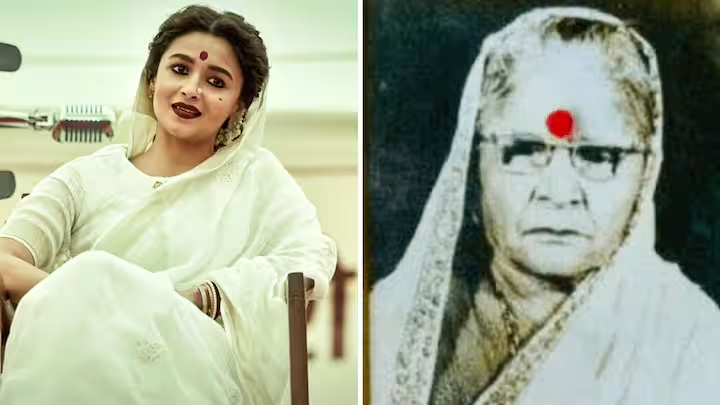
But as she transforms into the commanding “Madam of Kamathipura”, her wardrobe shifts dramatically. She dons white sarees, a bold choice not of mourning, but of power. These sarees are laced with chikankari, zari borders, and starched elegance, symbolizing both purity and defiance.
The jewellery is minimal yet striking. Oxidized silver bangles, nose rings, round bindis, and cat-eye sunglasses become part of her iconic look. Her aesthetic draws from real-life photographs of women in Kamathipura, merging vintage authenticity with cinematic sharpness.
Heeramandi: The Diamond Bazaar (2024)
Set in pre-independence Lahore during the 1920s and 1930s, Heeramandi unfolds in a time when the Mughal influence was fading but still visible in cultural pockets like the courtesan quarters.
Costumes in Heeramandi are meticulously rooted in history. The tawaifs wear traditional anarkalis, shararas, and angarkhas. Silhouettes historically popular in Awadh and Punjab’s elite Muslim courts. These garments, made in handwoven silks, brocades, velvets, and tissue fabrics. The embroidery techniques such as zardozi, gota patti, dabka, and mukaish were common in royal ateliers and accurately represent the time’s craftsmanship.
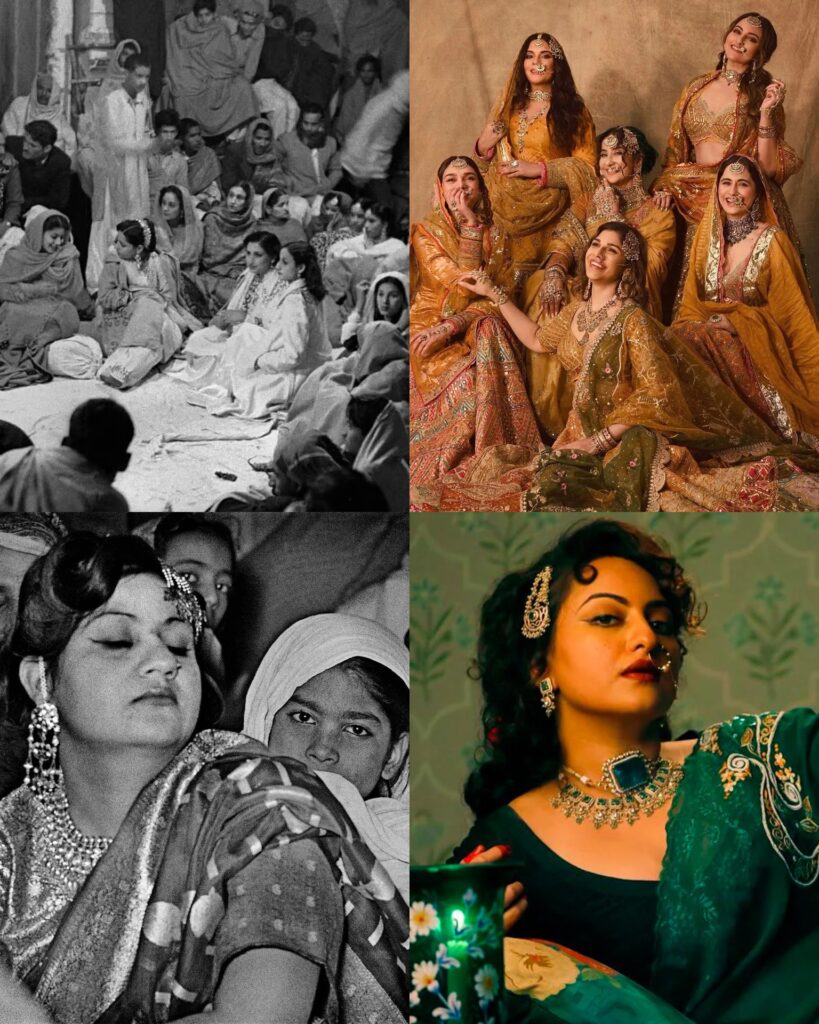
Jewellery draws directly from Mughal and early colonial-era collections, with signature pieces like maang tikkas, passas, chaandbalis, and polki rani haars. Which were indicators of wealth, patronage, and refinement. Courtesans were cultural icons, not merely performers, and their attire mirrored their status as custodians of poetry, dance, and etiquette.
Bhansali’s films speak to the soul because of how precise, emotionally rich, and historically accurate his visual storytelling is. Stay tuned for more articles at The World Times.

